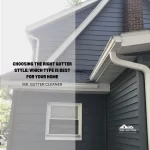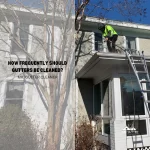Gutter guards serve a crucial role in home maintenance by preventing leaves and debris from clogging gutters, thus facilitating smoother water flow away from the house structure.
Despite their utility, homeowners often encounter a range of problems with these protective barriers. Issues range from the accumulation of debris on top of the guards, water overflow during heavy rains, to unexpected damage or wear over time.
These challenges not only compromise the functionality of gutter guards but can also lead to more significant issues like water damage to the home’s foundation and landscape. Additionally, the presence of gutter guards does not eliminate the need for regular maintenance; instead, it changes the nature of the maintenance required.
Understanding these common problems is essential for homeowners to take proactive steps in choosing the right type of gutter guard, implementing regular maintenance schedules, and addressing issues promptly to protect their homes effectively.
This introduction sets the stage for a deeper exploration into each common gutter guard problem, providing homeowners with the information needed to manage and mitigate potential risks effectively.
What Are Gutter Guards and How Do They Work?
Gutter guards play a vital role in home maintenance by preventing leaves, debris, and other materials from blocking the gutters. These devices allow water to flow freely through the gutters while filtering out materials that could lead to blockages. By maintaining clear gutters, homeowners can avoid water damage to their property’s foundation, siding, and landscaping.
Why Do Homeowners Install Gutter Guards?
Homeowners install gutter guards to reduce the frequency of gutter cleaning and to protect their homes from the risks associated with clogged gutters, such as water damage and foundation problems. Gutter guards offer peace of mind by ensuring that gutters function efficiently, even during heavy rains.
Table of Contents:
- What Are Gutter Guards and How Do They Work?
- The Top 8 Gutter Guard Problems Homeowners Face
- How to Choose the Right Gutter Guard for Your Home
- Preventive Measures and Regular Maintenance Tips
- Troubleshooting Common Gutter Guard Issues
- The Impact of Neglecting Gutter Guard Maintenance
- Making an Informed Decision on Gutter Guards
Different Types of Gutter Guards Explained
There are several types of gutter guards, each with its own set of advantages and disadvantages. Screen guards provide a simple barrier against leaves and large debris, while mesh guards offer finer filtration. Foam guards fit directly inside the gutter, blocking debris from entering, and surface tension guards, which are installed at an angle, allow water to flow over the edge and into the gutter while debris falls to the ground.
The Top 8 Gutter Guard Problems Homeowners Face
Despite their benefits, gutter guards are not without issues. Homeowners often face several common problems that can affect the performance and efficiency of their gutter protection system.
Clogging with Leaves and Debris
One of the most frequent issues is the clogging of gutter guards with leaves and debris, which can obstruct water flow and lead to overflow.
Why Does Clogging Occur Even With Gutter Guards?
Clogging occurs even with gutter guards because not all guards are designed to block all types of debris. Smaller particles, like pine needles and seeds, can still pass through or accumulate on the guard, reducing its effectiveness.
Water Overflow and Mismanagement
Water overflow and mismanagement can result from clogged gutter guards, leading to potential damage to the home’s foundation and landscaping.
How Can Water Overflow Damage Your Home?
Water overflow can damage your home by saturating the soil around the foundation, causing leaks and cracks. It can also damage landscaping and lead to erosion.
Gutter Guard Durability Issues
Gutter guards can suffer from durability issues, with some materials deteriorating faster than others due to weather exposure and debris accumulation.
What Materials Fail Most Often?
Materials that fail most often include plastic and foam, which can degrade under UV light and extreme weather conditions, and metal guards, which may corrode or rust over time.
The Challenge of Pest Intrusion
Gutter guards can inadvertently create habitats for pests such as rodents and insects, leading to potential infestations.
Why Do Gutter Guards Attract Pests?
Gutter guards attract pests because they provide shelter and nesting sites, especially if debris accumulates on or in them, offering materials for nests.
Installation Complications
Improper installation of gutter guards can lead to issues such as poor fit, gaps, and inefficiency in water management.
Common Mistakes During Gutter Guard Installation
Common mistakes during gutter guard installation include not securing the guards properly, choosing the wrong type of guard for the gutter system, and failing to account for the roof’s slope and type.
Maintenance and Cleaning Difficulties
Even with gutter guards, some maintenance is required to ensure they remain effective, contradicting the belief that they are maintenance-free.
How Often Should Gutter Guards Be Cleaned?
Gutter guards should be cleaned at least once or twice a year, depending on the surrounding environment and the type of guard installed, to prevent clogging and maintain optimal performance.
How to Choose the Right Gutter Guard for Your Home
Selecting the appropriate gutter guard is crucial for minimizing maintenance while maximizing performance. The right choice depends on various factors, including the type of debris commonly found around your home and the specific needs of your gutter system.
Evaluating Gutter Guard Materials and Types
Material and type are pivotal in determining a gutter guard’s effectiveness and longevity. Mesh and micro-mesh guards offer high filtration levels, suitable for fine debris, while foam and brush guards provide easy installation but may require more maintenance. Metal guards, although durable, may need checks for corrosion, whereas plastic options are cost-effective but may degrade under UV exposure. Assessing these materials in the context of your environment ensures a tailored approach to gutter protection.
Considering Your Home’s Surrounding Environment
Your home’s environment significantly influences gutter guard selection. Dense foliage necessitates guards capable of handling large volumes of leaves, whereas areas prone to smaller debris like pine needles might benefit from micro-mesh systems. Additionally, regions experiencing heavy rainfalls require guards designed for rapid water flow, preventing overflow and water damage.
Preventive Measures and Regular Maintenance Tips
Regular maintenance and the implementation of preventive measures are essential for extending the life of gutter guards and ensuring their effectiveness in protecting your home from water-related damage.
Schedule for Regular Gutter Maintenance
Establishing a regular maintenance schedule is crucial. Inspecting and cleaning gutter guards bi-annually, typically in spring and fall, helps prevent clogging and ensures they are in good condition. This routine can vary based on the surrounding environment and the type of gutter guards installed.
DIY Maintenance Tips vs. Professional Services
Homeowners can perform basic gutter guard maintenance, such as removing visible debris and flushing the gutters with water. For more thorough cleaning or when dealing with high, hard-to-reach gutters, professional services offer expertise and safety. They can also inspect for and repair any damage that might compromise the gutter system’s integrity.
Troubleshooting Common Gutter Guard Issues
Proactively addressing gutter guard problems ensures the longevity of your gutter system and safeguards your home against water-related damage. Here, we outline solutions for the most common issues, providing homeowners with the knowledge to maintain an effective gutter guard system.
Solutions for Clogged Gutter Guards
Regular inspections and cleaning are crucial for preventing clogs. If debris accumulates on top of gutter guards, gently remove it with a soft brush or blower. For internal clogs, flushing the gutters with a hose can help clear the system.
Addressing Water Overflow Problems
Water overflow often indicates a blockage or improper installation. Check for and remove any obstructions in the gutter guard or downspout. Ensure gutter guards are correctly aligned with the gutter’s slope to facilitate proper water flow.
Repairing Damaged Gutter Guards
Inspect your gutter guards for signs of wear or damage, such as holes or dislodged sections. Minor issues may be repairable with sealant or additional fasteners. For significant damage, replacement of the affected sections or the entire system may be necessary.
The Impact of Neglecting Gutter Guard Maintenance
Neglecting gutter guard maintenance can have immediate and long-term effects on your home’s safety and value.
Understanding these consequences motivates homeowners to adopt a consistent maintenance schedule.
Short-term and Long-term Consequences
In the short term, neglected gutter guards can lead to water damage, pest infestations, and ice damming.
Long-term effects include compromised structural integrity, reduced curb appeal, and potential loss of property value. Regular maintenance mitigates these risks, preserving the health and aesthetics of your home.
How Neglect Affects Home Safety and Value
Neglecting gutter guard maintenance jeopardizes your home’s foundation by allowing water to pool around the base, potentially leading to costly repairs. Additionally, it can lower your home’s market appeal and value, as potential buyers often scrutinize the upkeep of essential home maintenance systems.
Making an Informed Decision on Gutter Guards
Choosing the right gutter guard involves weighing the benefits against potential maintenance requirements and costs. This decision is crucial for ensuring the effectiveness of your home’s gutter system.
Balancing Cost, Effectiveness, and Maintenance
Consider the initial cost, expected lifespan, and maintenance needs of different gutter guard types. A higher upfront investment in durable, low-maintenance gutter guards can save money and time in the long run.
When to Consult a Professional
If you’re unsure which gutter guard system best suits your home, consulting a professional can provide clarity. Experts can offer personalized recommendations based on your home’s specific needs, ensuring optimal protection against gutter-related issues.


